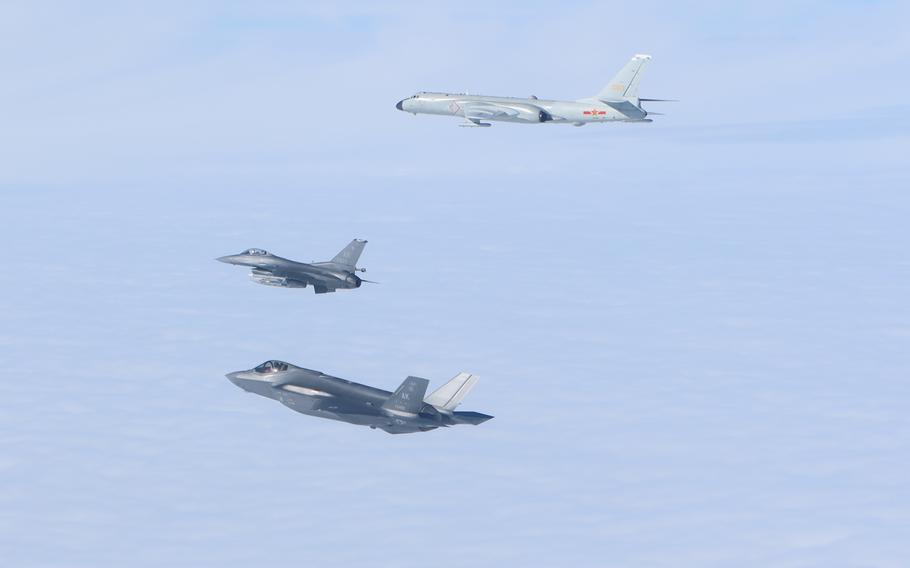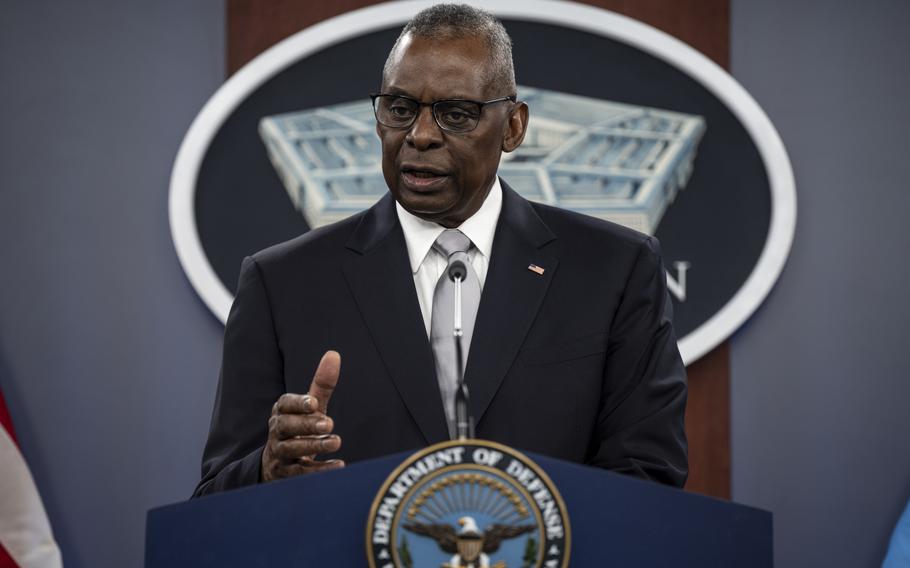
Two CF-18 Hornets, two F-35 Lighting II and two F-16 Fighting Falcons fighter jets from NORAD identified and intercepted two Russian TU-95 and two Chinese H-6 military aircraft operating in the Alaska Air Defense Identification Zone on July 24, 2024. (Department of Defense)
WASHINGTON — Defense Secretary Lloyd Austin said Thursday that the Defense Department has been tracking cooperation between Russia and China but spotting military aircraft from the two countries flying together near Alaska was new.
“This is the first time that we’ve seen those two countries fly together like that. They didn’t enter our airspace,” Austin told reporters during a news conference at the Pentagon. “This is a thing that we track very closely. If it happens again … I have every confidence in [U.S. Northern Command] and [North American Aerospace Defense Command] will be at the ready.”
On Wednesday, U.S. and Canadian fighter jets intercepted four aircraft — two Russian bombers and two Chinese bombers — flying near Alaska. Austin said the closest point of approach was about 200 miles off the U.S. coast.
U.S. adversaries “are always testing us,” Austin said, and the military often sees activity in the north.
But the Pentagon has growing concern about the relationship between China and Russia because China has increased its support to Russia since its invasion of Ukraine in February 2022, he said.
“We’ve seen evidence of that, and we would hope that would cease going forward,” said Austin as he prepares to leave Friday for his 11th trip to the Indo-Pacific region, where he will visit Japan and the Philippines. “We’ll see what happens and how this relationship continues to develop.”
The Russian Tupolev Tu-95 Bears and Chinese H-6 strategic bombers were operating in the Alaska Air Defense Identification Zone, but the aircraft “did not enter American or Canadian sovereign airspace,” according to a NORAD statement. The Alaska Air Defense Identification Zone is an area beyond U.S. airspace where, for national security, it exerts some air traffic control and requires aircraft to identify themselves.
Such incidents have occurred as often as 15 times per year in the recent past, NORAD has said. But just as the U.S. regularly intercepts aircraft near its borders, Russian aircraft intercept American flights near its airspace.

Defense Secretary Lloyd Austin conducts a news briefing at the Pentagon on Feb. 1, 2024. (Alexander Kubitza/Department of Defense)
Russian fighters on Sunday intercepted a pair of Air Force B-52 Stratofortress bombers in international airspace over the Barents Sea, the area north of Scandinavia and eastern Russia. The U.S. bombers were en route to Mihail Kogalniceanu Air Base in Romania, according to the service.
The B-52s continued their flight without changing course, according to U.S. Air Forces Europe and Africa.
The incident Wednesday also comes after the Pentagon two days earlier unveiled its new Arctic strategy as warmer weather opens more waterways and allows Russia and China to threaten stability in the region.
Russia, the largest of the eight Arctic nations, has built up military infrastructure in the region and has a clear route to the U.S. through the Arctic. Russia’s Arctic access could be used to constrain the ability of the United States to respond to crises in Europe and the Indo-Pacific regions, according to the Pentagon’s updated strategy.
Additionally, China declared itself a “near-Arctic state” in 2018, signaling interest in the region. Russia and China have been collaborating on development in the Arctic, as well as conducting joint training exercises for years, raising U.S. and NATO concerns.